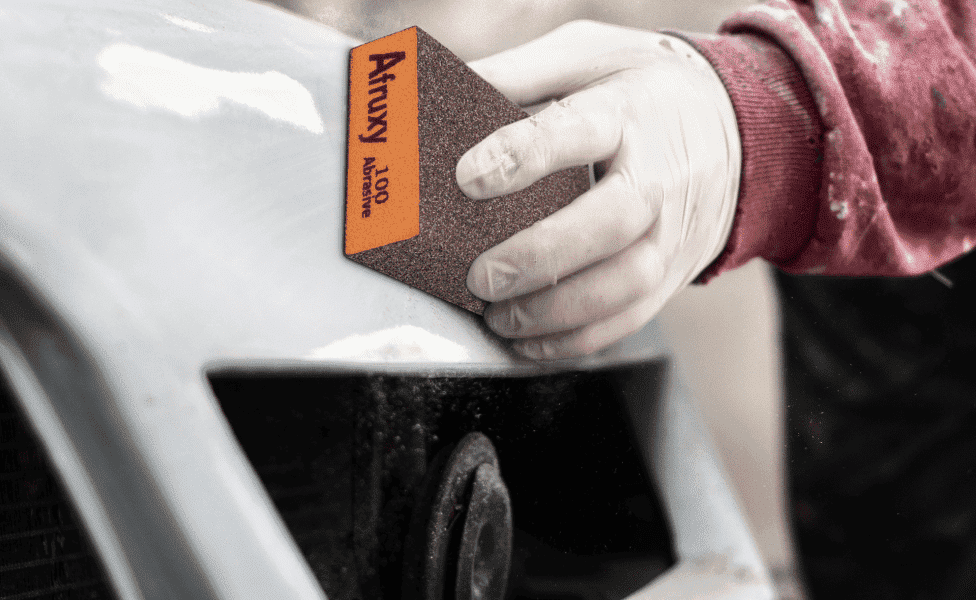Automotive sanding sponges are indispensable tools used in the automotive industry for various sanding and finishing tasks. They are versatile, handheld tools that combine the convenience of a sponge with abrasive properties. In this article, we will explore the importance of grit selection, where and how to use automotive sanding sponges effectively for automotive applications.
Grit Selection:
Automotive sanding sponges come in a range of grit sizes, which determine the coarseness or fineness of the abrasive material. The grit number represents the number of abrasive particles per square inch on the sanding surface. The higher the grit number, the finer the sanding sponge.
- Coarse Grits (60-120): Coarse grit sanding sponges are ideal for heavy material removal, such as shaping body filler, removing paint, or sanding rough surfaces. They are typically used in the initial stages of surface preparation.
- Medium Grits (150-220): Medium grit sanding sponges are suitable for feathering edges, smoothing out imperfections, and preparing surfaces for paint or primer application. They help create a smoother surface and remove visible scratches left by coarser grits.
- Fine Grits (240-400+): Fine grit sanding sponges are used for final sanding before painting or applying clear coat finishes. They help achieve a polished and smooth surface, removing any remaining imperfections and providing a suitable surface for paint adhesion.
Where to Use Sanding Sponges in Automotive:
- Body Filler and Putty:Sanding sponges are effective in shaping and smoothing body filler and putty, ensuring a seamless transition between repaired areas and the surrounding surface.
- Paint Removal:When preparing a vehicle for repainting, sanding sponges are useful for removing old paint, clear coats, or primers. They offer control and flexibility in accessing curved or intricate areas.
- Surface Preparation:
Sanding sponge essential for surface preparation before painting. They help create a clean and smooth surface by removing rust, dirt, and imperfections.
- Sanding Between Coats:Between paint or clear coat layers, sanding sponges can be used to remove dust particles, orange peel texture, or minor imperfections, ensuring a smooth and even surface.
Best Practices for Using Sanding Sponges:
- Safety First:Always wear appropriate safety gear, such as goggles and a dust mask, to protect yourself from airborne particles and dust.
- Start with Coarser Grits:Begin with a coarser grit sanding sponge to remove major imperfections or rough surfaces, gradually progressing to finer grits for a smoother finish.
- Wet or Dry Sanding:Depending on the application, automotive sanding sponges can be used either wet or dry. Wet sanding reduces dust and clogging, providing better control and a smoother finish.
- Sanding Technique:Use light to moderate pressure, moving the sanding sponge in even strokes. Avoid applying excessive pressure, as it may result in uneven sanding or damage to the surface.
- Regular Cleaning:Clean the sanding sponge regularly by rinsing it with water or using a cleaning brush to remove debris and prevent clogging. This ensures optimal performance and longevity.
Conclusion
Automotive sanding sponges are versatile tools that aid in various automotive tasks, from surface preparation to paint removal and finishing. Selecting the appropriate grit, knowing where and how to use them effectively, and following best practices will result in high-quality automotive finishes and optimal results. Remember to prioritize safety and proper maintenance to maximize the lifespan of your sanding sponges and achieve professional-grade automotive outcomes.
Frequently Asked Questions (FAQs)
Can automotive sanding sponges be used on all surfaces?
Automotive sanding sponges are designed for use on automotive surfaces, such as metal, plastic, and fiberglass. However, it’s essential to consider the specific requirements of the surface you are working on. Always test a small, inconspicuous area before proceeding with extensive sanding.
What is the difference between dry sanding and wet sanding?
Dry sanding involves using the sanding sponge without any additional liquid. Wet sanding, on the other hand, involves using water or a lubricating solution to reduce dust and prevent clogging. Wet sanding generally provides a smoother finish and is commonly used for automotive applications.
How often should I clean the sanding sponge during use?
It is advisable to clean the sanding sponge regularly during use, especially when working with clog-prone materials like paint or body filler. Rinse the sponge with water or use a cleaning brush to remove debris and prevent clogging, ensuring consistent performance.
Can I reuse automotive sanding sponges?
Automotive sanding sponges can be reused multiple times, depending on the extent of use and the condition of the sponge. Regular cleaning and proper maintenance can extend their lifespan. However, it’s important to monitor the sponge’s abrasive quality and replace it when it becomes worn or ineffective.
How do I choose the right grit for my automotive sanding sponge?
The choice of grit depends on the specific task at hand. Coarser grits (60-120) are suitable for heavy material removal, medium grits (150-220) are ideal for surface leveling and preparation, and fine grits (240-400+) are used for final sanding and achieving a smooth finish. Assess the surface condition and determine the level of abrasiveness required for your application.
Can automotive sanding sponges remove deep scratches or dents?
While automotive sanding sponges can help reduce the appearance of shallow scratches and imperfections, deep scratches or dents typically require more extensive repair techniques. It is best to consult a professional for severe damage to ensure proper restoration.
Are there any safety precautions I should follow when using automotive sanding sponges?
Yes, it is important to prioritize safety when using sanding sponges. Wear appropriate personal protective equipment (PPE), such as safety goggles and a dust mask, to protect yourself from dust and airborne particles. Additionally, ensure proper ventilation in your workspace to minimize exposure to harmful fumes, if any.
Remember, if you have any specific concerns or questions about using automotive sanding sponges, it’s always recommended to consult with experts or professionals in the automotive industry for guidance.



